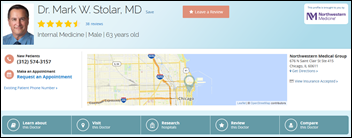News 12/23/16
Top News

The Department of Justice gives anti-trust clearance to the previously announced creation of a new health IT company by McKesson and Change Healthcare, clearing the way for the deal to go through as planned in the first half of 2017.
McKesson will own 70 percent of the new company, to which it will contribute most of McKesson Technology Solutions.
Reader Comments
From CCOW, MUCOW: “Re: Meaningful Use penalties. A CMS document says it will apply a downward payment adjustment to 171,000 EPs in 2017 for failing to demonstrate MU.” I’ve long lost interest in Meaningful Use and its offspring. We as taxpayers have paid $35 billion to bribe doctors to use old, poor-selling EHRs they wouldn’t use voluntarily, which is maybe a first in any industry. I suppose that as a stimulus package, it delivered the expected economic benefit (although it was late to the party by the time the details were worked out), but I’m not seeing much difference in cost or quality so far. Maybe it’s a laying-the-tracks sort of thing that will pay for itself downstream. Meanwhile, I read somewhere that ONC now has 400 employees, reproducing itself like typically virulent federal agencies, departments, and offices.
From Piezo DeVoltaic: “Re: equipment. Other than the Wi-Fi adapter you mentioned, what else do you use to write HIStalk?” I have a Toshiba laptop that I got from Office Depot for less than $300 several years ago and a 27-inch Acer monitor that I think cost around $130. That’s it other than keyboards, which I go through frequently due to the volume of writing I put out – I buy the basic Microsoft wired keyboards three at a time since they’re only around $12. Starting on a new keyboard is like a new beginning because I’m always snacking while working due to lack of time, so the crumb load is significant (shaking my keyboard upside down looks like a snowstorm). On the non-work front, I have an iPad Mini and my beloved Chromebook. I also need to replace my iPhone 5 at some point, I suppose, although I can’t get excited about the iPhone 7 Plus that seems like its logical successor.

From LFI Masuka: “Re: article comparing medicine to ‘Moneyball.’ The movie was really about using statistics to better value assets in an environment of limited money to spend on those assets. The vision was not getting the best possible Oakland A’s – it was getting the best Oakland A’s for a reasonable price. The equivalent for medicine would not be best practices – it would be to set up budgeted compensation guidelines to more realistically address those activities that promote long-term health. Getting more bang for our collective bucks. Without the financial aspect, Medicineball is what we used to call ‘science.’” I like that. I would also say that it’s a subtle but important mistake to assume that hospitals are best equipped to do anything more than patch people up and send big bills after they treat ‘em and street ‘em. Somehow everybody just accepts that hospitals are the logical overseers of population health management. I disagree. Most of us see our PCPs a lot more often than we have a hospital encounter, not to mention that hospitals are notoriously bureaucratic and inefficient. Maybe it’s because the doors of medical practices are locked at least 75 percent of the time, sticking hospitals with less-convenient coverage hours but making them the most reliable and accessible provider. I’ve spent most of my career working in hospitals and I would never (a) donate money to them, (b) trust them; or (c) become their inpatient without having someone sitting at the foot of my bed at all times to catch their inevitable mistakes. They’re like universities – too much emphasis on money, overly large employee egos, and an inflated sense of entitlement and global self-importance.
HIStalk Announcements and Requests

Donations from three HIStalk readers, paired with matching money from my anonymous vendor executive, allowed me to fund these DonorsChoose projects:
- An Osmo Wonder Kit for Ms. F’s sixth grade class in Costa Mesa, CA
- Science, STEM, and weather books Ms. H’s second grade class in Fayetteville, NC
- Scientific calculators for Ms. H’s seventh grade class in Indianapolis, IN
Ms. H responded quickly to the news that her project was funded. “I am so grateful that you are helping us out. We do not get a lot of science materials in second grade. This is exactly what I needed for my students when we come back from the winter break. I can’t tell you how much this means to me to give my students the best so they can learn. My kids love science and now you are giving us materials for them to really dig in and learn. You are the best.”


Ms. C sent photos from her California middle school showing the daily news show equipment we provided in funding her DonorsChoose grant request (microphones, a $50 camera-equipped drone, iPhone tripods and clips, and accessories).
A TV show is on in the background as I’m writing, in which a limelight-seeking singer is butchering a Christmas carol with overwrought vocal gymnastics in an ill-advised attempt to “make it her own” instead of just singing the damned thing without gimmicking it up. The only worse thing I’ve heard is when a “Nashville recording artist” wearing a laughably misplaced cowboy hat hacks up the National Anthem before a Nascar race, providing 10 bad, rambling notes for every one that was originally written. Even the “artists” who follow the Star-Spangled Banner reasonably well still feel compelled to wing it toward the end, probably in relief for remembering all the words. Apparently they are mistaken in thinking they know better than the composer.
This week on HIStalk Practice: Fallas Family Vision selects RevolutionEHR. Greenwood Genetic Center launches telegenetics program in South Carolina. Michigan will implement Appriss Health’s prescription monitoring program tech. Orthopedic + Fracture Specialists goes with Odoro patient self-scheduling software. MedStar NRH’s John Brickley outlines the challenges PTs face when selecting health IT. Our Children Our Future selects TenEleven Group’s behavioral health EHR. Walgreens looks to Matter for innovation inspiration as it works out Theranos kinks. Palo Alto Networks’ Matt Mellen offers ways to spot spoofing in healthcare emails.
I’m leaning toward taking the weekend off from writing HIStalk, so if indeed I do, have a Merry Christmas or whatever holiday (if any) you celebrate. I don’t gain much wisdom from Facebook, but I liked a quote I saw there: “It’s not what’s under the Christmas tree — it’s who’s around it.”
Webinars
January 18 (Wednesday) 1:00 ET. “Modernizing Quality Improvement Through Clinical Process Measurement.” Sponsored by LogicStream Health. Presenters: Peter Chang, MD, CMIO, Tampa General Hospital; Brita Hansen, MD, CHIO, Hennepin County Medical Center. The presenters will describe how they implemented successful quality governance programs, engaged with their health system stakeholders, and delivered actionable information to clinical leadership and front-line clinicians. Q&A will follow.
January 26 (Thursday) 1:00 ET. “Jump Start Your Care Coordination Program: 6 Strategies for Delivering Efficient, Effective Care.” Sponsored by Healthwise. Presenters: Jim Rogers, RN, RPSGT, director of healthcare solutions, Persistent Systems; Charlotte Brien, MBA, solutions consultant, Healthwise. This webinar will explain how to implement a patient-centered care coordination program that will increase quality as well as margins. It will provide real-world examples of how organizations used care coordination to decrease readmission rates, ED visits, and costs.
Sales

In England, Allscripts PAS customer Dudley Group NHS Foundation Trust adds Sunrise and dbMotion.

Deborah Heart and Lung Center (NJ) will upgrade to Meditech Web Ambulatory and 6.1.
In England, Imperial College Healthcare NHS Trust will implement Google-owned DeepMind clinical deterioration detection system.
Announcements and Implementations
Eight large health systems go live with the Surescripts National Record Locator Service. The company offers EHR vendors free access to the system, which operates under Carequality’s framework, until 2019.
Privacy and Security
From DataBreaches.net:
- A security firm’s analysis finds that the black market price of a patient’s complete medical record has dropped over several years from $50 to less than $10, which has caused cybercriminals to refocus their efforts on spreading the more profitable ransomware.
- Fairbanks Hospital (IN) notifies an unspecified number of patients that their information was visible to unauthorized employees for several years, adding that it’s not even sure who viewed the information.
- Henry County Health Department (OH) alerts 500 of its home health and hospice patients that their information was contained on a nurse’s stolen laptop, adding that it will start encrypting laptops.
- Community Health Plan of Washington notifies 400,000 current and former members that a security vulnerability in the network of contractor NTT Data exposed their information.
Innovation and Research
A Geisinger study in which patient genomes were matched to their EHR information finds actionable variants for familial hypercholesterolemia in 3.5 percent of those studied.
Other
The $125 million that UMass Memorial Health Care (MA) borrowed for its Epic implementation reduced its fiscal year operating profit, but it still made $47 million vs. $58 million last year.
Saint Vincent Hospital (PA) is forced by the Equal Employment Opportunity Commission to rehire six former employees it fired in 2013 for refusing to take a flu shot and then providing questionable clergy-signed documentation of their claimed religious beliefs. EEOC says the hospital’s requirement constitutes religious discrimination. The hospital must now accept any excuse an employee offers for declining to be immunized.

Denver Health (CO) fires $360,000-per-year pediatric anesthesiologist Michelle Herren, MD for posting Facebook comments about First Lady MIchelle Obama that said, “Doesn’t seem to be speaking too eloquently here, thank god we can’t hear her! Harvard??? That’s a place for ‘entitled’ folks said all the liberals! Monkey face and poor ebonic English!!! There! I feel better and am still not racist!!! Just calling it like it is!" She apologized, saying she didn’t realize “monkey face” might be taken as racist, that her comments were taken out of context, and that she thinks it’s a double standard that everyone can make fun of Melania Trump but the First Lady is off limits. Unlike Ms. Obama’s degrees from Princeton and Harvard, the exclamation point-shrieking Dr. Herren earned her medical degree from Nebraska’s Creighton University, ranked among the bottom 15 US medical schools.
Weird News Andy offers his Merry Christmas story. New Mexico Department of Health epidemiologists investigate their own agency’s catered holiday lunch after 70 of its employees get sick afterward. I don’t usually worry about catered food, but I’m nervous about eating at potlucks or picnics, where you can’t verify the food safety standards employed by well-intentioned people who don’t understand that food needs to be refrigerated as soon as it’s cooked and until it’s heated and eaten. Compounding the problem is that hospitals and office buildings don’t always have a real kitchen with big enough refrigerators to hold everybody’s dishes for several hours or a range to heat them up, so there’s always a big line waiting for the cheap, countertop microwave. Think twice before you take leftovers home. Sometimes I think that every American should take a food safety course since it’s surprising how many people leave food out after cooking or after eating, somehow thinking that simply covering it keeps bacteria out.
Sponsor Updates
Holiday Activities
PeriGen and its new acquisition WatchChild hold their first combined team meeting in Cary, NC, with employees also building 10 bicycles for the local Big Brothers, Big Sisters organization, They were surprised afterward to be joined by the children whose bikes they had just built.

Xerox Healthcare donates gifts to the Northern Rivers Holiday Giving Campaign.
- Consulting Magazine awards Impact Advisors VP Jenny McCaskey a Lifetime Achievement Award.
- Everest Group places NTT Data Services in the Leader quartile for three of the 2016 Peak Matrix Assessments, including the new EHR category.
- PatientKeeper releases a new video featuring customer reviews of their charge-capture solution.
- The SSI Group raises money to place over 400 wreaths on the graves of veterans.
Blog Posts
- Getting nurses back to the bedside (Infor)
- Top 5 Healthcare IT Buzzwords You Need To Know (Access)
- Our Year in Review: What Navicure’s 2016 Surveys Tell Us about Organizational Goals and Achievements (Navicure)
- Get Ready for Blockchain’s Disruption: A HIStalk Blog Recap (PokitDok)
- How to increase the impact of smart mobile devices (PerfectServe)
- The Importance of Longer EFM Views (PeriGen)
- Top Conferences for Healthcare Privacy and Compliance Officers in 2017 (Protenus)
- How Streamline Health is about to change code auditing forever (Streamline Health)
- Summit Provider Exchange – Tips and Tricks (Summit Healthcare)
- Strategic Planning: Rethinking Your Hybrid IT Strategy in 2017 (TierPoint)
- Tips to ensure your quality program actually improves quality (Verscend)
- RSNA in Perspective: Streamlining Workflows, Reducing Costs, Improving Outcomes (Vital Images)
- A Better Contact Center for a Better Customer Experience (West Corp.)
Contacts
Mr. H, Lorre, Jennifer, Dr. Jayne, Lt. Dan.
More news: HIStalk Practice, HIStalk Connect.
Get HIStalk updates. Send news or rumors.
Contact us.












































































































































































Anything related to defense will need to go to Genesis.